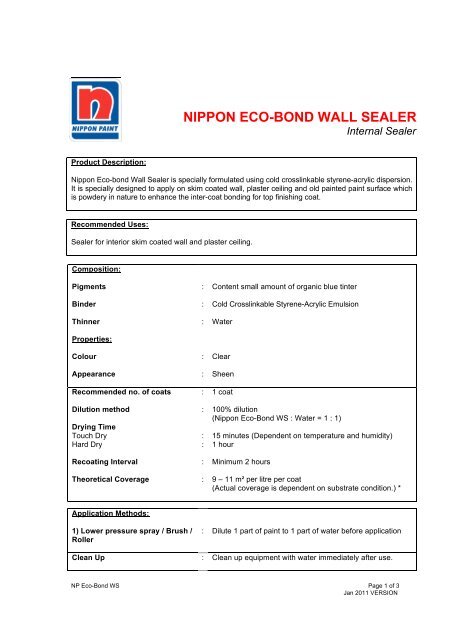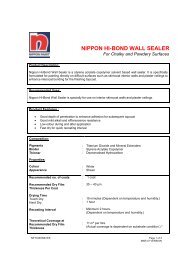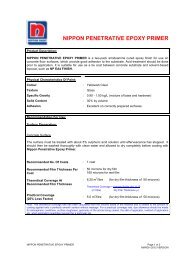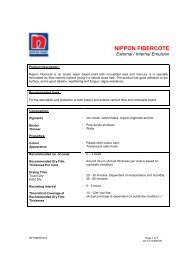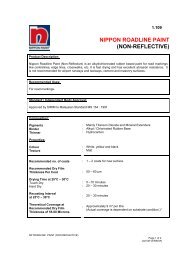5) Nippon Eco-Bond Wall Sealer - Nippon Paint Malaysia
5) Nippon Eco-Bond Wall Sealer - Nippon Paint Malaysia
5) Nippon Eco-Bond Wall Sealer - Nippon Paint Malaysia
You also want an ePaper? Increase the reach of your titles
YUMPU automatically turns print PDFs into web optimized ePapers that Google loves.
NIPPON ECO-BOND WALL SEALER<br />
Internal <strong>Sealer</strong><br />
Product Description:<br />
<strong>Nippon</strong> <strong>Eco</strong>-bond <strong>Wall</strong> <strong>Sealer</strong> is specially formulated using cold crosslinkable styrene-acrylic dispersion.<br />
It is specially designed to apply on skim coated wall, plaster ceiling and old painted paint surface which<br />
is powdery in nature to enhance the inter-coat bonding for top finishing coat.<br />
Recommended Uses:<br />
<strong>Sealer</strong> for interior skim coated wall and plaster ceiling.<br />
Composition:<br />
Pigments<br />
Binder<br />
Thinner<br />
Properties:<br />
Colour<br />
Appearance<br />
Recommended no. of coats<br />
Dilution method<br />
Drying Time<br />
Touch Dry<br />
Hard Dry<br />
Recoating Interval<br />
Theoretical Coverage<br />
:<br />
:<br />
:<br />
:<br />
:<br />
:<br />
:<br />
:<br />
:<br />
:<br />
:<br />
Content small amount of organic blue tinter<br />
Cold Crosslinkable Styrene-Acrylic Emulsion<br />
Water<br />
Clear<br />
Sheen<br />
1 coat<br />
100% dilution<br />
(<strong>Nippon</strong> <strong>Eco</strong>-<strong>Bond</strong> WS : Water = 1 : 1)<br />
15 minutes (Dependent on temperature and humidity)<br />
1 hour<br />
Minimum 2 hours<br />
9 – 11 m² per litre per coat<br />
(Actual coverage is dependent on substrate condition.) *<br />
Application Methods:<br />
1) Lower pressure spray / Brush /<br />
Roller<br />
: Dilute 1 part of paint to 1 part of water before application<br />
Clean Up : Clean up equipment with water immediately after use.<br />
NP <strong>Eco</strong>-<strong>Bond</strong> WS Page 1 of 3<br />
Jan 2011 VERSION
Surface Preparation:<br />
Remove all loose, defective paint or powdery residues. Repair cracks, uneven surfaces with <strong>Nippon</strong><br />
ACS Putty or suitable fillers. Smoothen the putty / filler areas with sandpaper. Surfaces to be<br />
painted must be cleaned thoroughly and dry, it must be free from dirt, grease and other foreign<br />
matters. Allow all surfaces to dry completely prior to painting. Avoid painting when the moisture<br />
content and alkalinity of the walls are still high. (Recommended painting specification requires the<br />
moisture content of the walls to be below 16% measured by protimeter and alkalinity of the walls to<br />
be below pH9.)<br />
Previously <strong>Paint</strong>ed Surfaces<br />
Remove all unstable paint film, loose chalk, dust and foreign matter. Make good any surface defects,<br />
clean off and dry.<br />
Recommended <strong>Paint</strong> System<br />
Sequence Product Name No. of Coats<br />
<strong>Sealer</strong><br />
Finish<br />
NIPPON ECO-BOND WALL SEALER<br />
NIPPON INTERIOR PRODUCT<br />
1<br />
2<br />
Standard Packing :<br />
Safety, Health and Environmental Information:<br />
Keep container tightly closed and keep out of reach of children or away from food and drink.<br />
Ensure good ventilation during application and drying.<br />
When applying paint, it is advisable to wear eye protection.<br />
In case of contact with eye, rinse with plenty of water immediately and seek medical advice.<br />
Remove splashes from skin by using soap or water.<br />
<strong>Paint</strong> must always be stored in a cool place.<br />
When transporting paint, care must be taken. Always keep container in a secure upright<br />
position.<br />
Dispose off any paint waste in accordance with the appropriate Environmental Quality<br />
Regulations.<br />
Note:<br />
* Theoretical Coverage is based on a mathematical formula<br />
Volume Solid % x 10<br />
Dry Film Thickness<br />
= m² / lit / coat<br />
NP <strong>Eco</strong>-<strong>Bond</strong> WS Page 2 of 3<br />
Jan 2011 VERSION
and does not consider LOSS FACTORS.<br />
Variables like porosity of substrate, application method, dilution ratio, dry film thickness, opacity and<br />
so on will affect the loss factor and can vary from 30% - 50% or even more.<br />
The above information is given to the best of our knowledge based on laboratory tests and practical<br />
experience.<br />
However, since we cannot anticipate or control the many conditions under which our products may<br />
be used, we can only guarantee the quality of the product itself.<br />
We reserve the right to alter the given data without prior notice.<br />
NP <strong>Eco</strong>-<strong>Bond</strong> WS Page 3 of 3<br />
Jan 2011 VERSION


